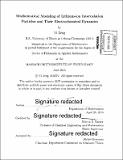| dc.contributor.advisor | Martin Z. Bazant. | en_US |
| dc.contributor.author | Zeng, Yi, Ph. D. Massachusetts Institute of Technology | en_US |
| dc.contributor.other | Massachusetts Institute of Technology. Department of Mathematics. | en_US |
| dc.date.accessioned | 2015-09-29T19:01:03Z | |
| dc.date.available | 2015-09-29T19:01:03Z | |
| dc.date.copyright | 2015 | en_US |
| dc.date.issued | 2015 | en_US |
| dc.identifier.uri | http://hdl.handle.net/1721.1/99062 | |
| dc.description | Thesis: Ph. D., Massachusetts Institute of Technology, Department of Mathematics, 2015. | en_US |
| dc.description | Cataloged from PDF version of thesis. | en_US |
| dc.description | Includes bibliographical references (pages 171-190). | en_US |
| dc.description.abstract | Lithium-ion battery is a family of rechargeable batteries with increasing importance that is closely related to everyone's daily life. However, despite its enormously wide applications in numerous areas, the mechanism of lithium-ion transport within the battery is still unclear, especially for phase separable battery materials, such as lithium iron phosphate and graphite. Mathematical modeling of the battery dynamics during charging/discharging will be helpful to better understand its mechanism, and may lead to future improvement in the battery technology. In this thesis, a new theoretical framework, the Cahn-Hilliard reaction (CHR) model, is applied to model the bulk phase separation dynamics of the single intercalated particle in the lithium-ion battery. After a study of the efficient numerical algorithm for solving nonlinear diffusion equations, we numerically investigate the thermodynamics and electrokinetics of the 1D spherical CHR model with different possible material properties in detail. We also extend the CHR model to 2D and briefly study the effects of the surface electron-conducting coating layer. We also work on the Marcus theory, which is demonstrated to be a better theoretical framework for heterogeneous electron transfer at the surface of intercalated particles in the batteries. We provide simple closed-form approximations to both the symmetric Marcus-Hush-Chidsey (MHC) and the asymmetric-Marcus-Hush (AMH) models by asymptotic technique. By avoiding the numerical evaluations of the improper integral in the old formulae, computing the surface reaction rate with the new approximation is now more than 1000 times faster than before. | en_US |
| dc.description.statementofresponsibility | by Yi Zeng. | en_US |
| dc.format.extent | 190 pages | en_US |
| dc.language.iso | eng | en_US |
| dc.publisher | Massachusetts Institute of Technology | en_US |
| dc.rights | M.I.T. theses are protected by copyright. They may be viewed from this source for any purpose, but reproduction or distribution in any format is prohibited without written permission. See provided URL for inquiries about permission. | en_US |
| dc.rights.uri | http://dspace.mit.edu/handle/1721.1/7582 | en_US |
| dc.subject | Mathematics. | en_US |
| dc.title | Mathematical modeling of lithium-ion intercalation particles and their electrochemical dynamics | en_US |
| dc.type | Thesis | en_US |
| dc.description.degree | Ph. D. | en_US |
| dc.contributor.department | Massachusetts Institute of Technology. Department of Mathematics | |
| dc.identifier.oclc | 921851714 | en_US |
